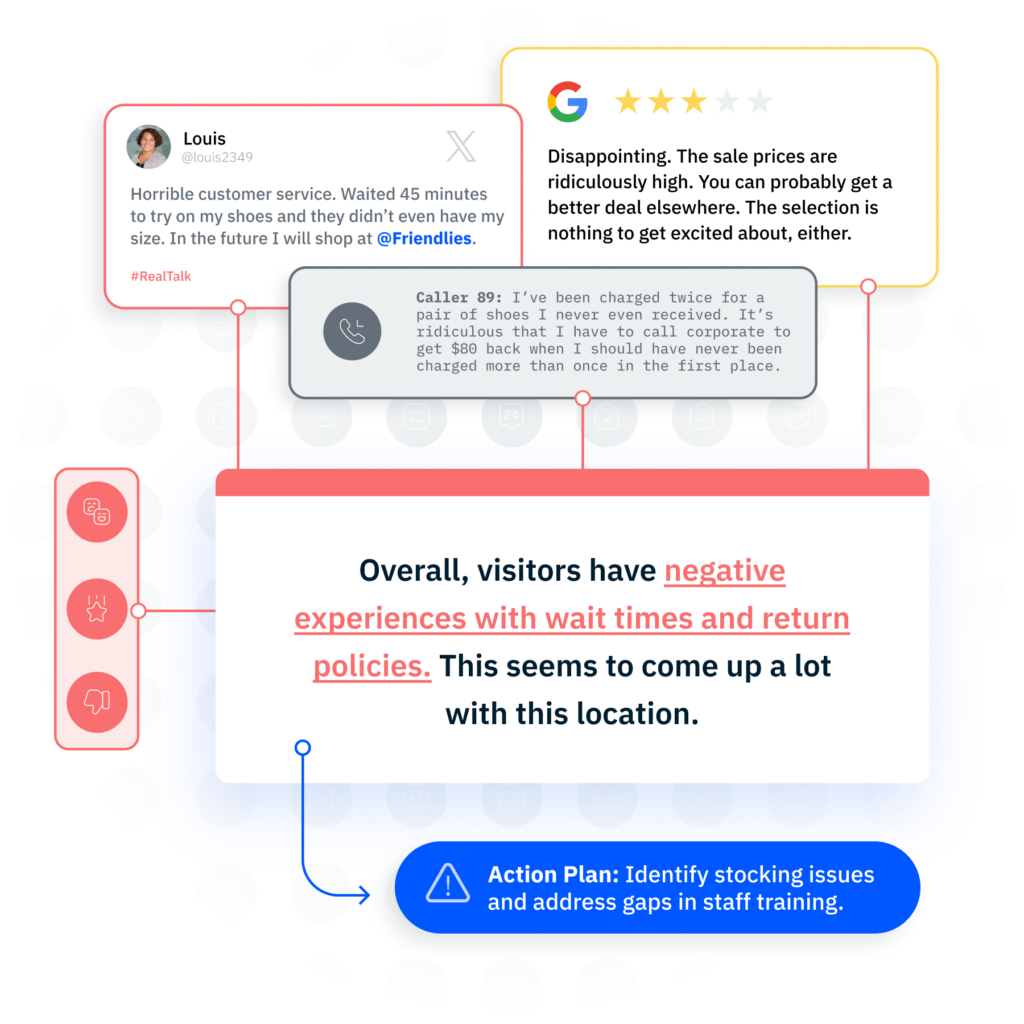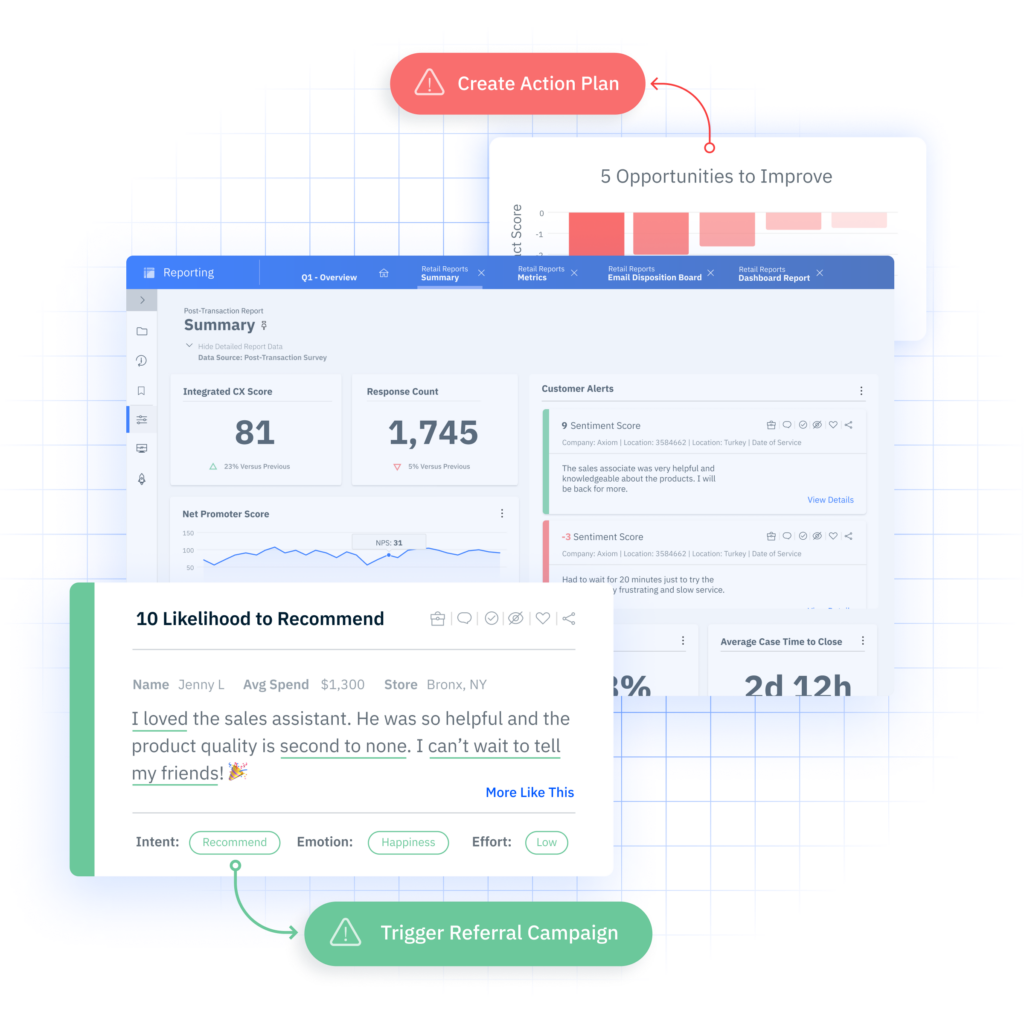In the midst of today’s bustling and intricate business landscape, deciphering the ever-evolving wants and needs of customers can feel like navigating through a maze. However, creating an integrated CX program can make this easier than you might think. At InMoment, we are dedicated to delivering tangible business value and bolstering your bottom line through a comprehensive integrated CX approach.
What is Integrated Customer Experience (CX)?
Integrated CX is all about harnessing the power of data, technology, and expert service to help companies unlock valuable insights so they can take action to drive measurable outcomes for their customers. It’s creating an integrated customer experience by seamlessly bringing together a wealth of information, utilizing cutting-edge technology, and providing top-notch service to reveal the hidden gems within your customer experience. By merging these elements, Integrated CX empowers businesses to make informed decisions, improve customer satisfaction, and drive success in an increasingly data-driven world. In short, integrated customer experience is an anti-siloed CX strategy.

Integrated CX vs. CX Integrations
While integrated CX and CX integrations may sound similar, they have different meanings and applications for businesses looking to improve their customer engagement.
Integrated customer experience revolves around breaking down data silos and consolidating customer data from diverse sources into a unified and accessible repository. The goal is to create a comprehensive view of the customer, drawing insights from various touch points such as interactions, purchases, and feedback. By amalgamating data from sources like sales, marketing, and customer support, integrated CX provides a holistic perspective, enabling organizations to understand customer behavior and preferences more thoroughly.
On the other hand, customer experience integrations focus on the collaborative efforts of different software applications to amplify the capabilities of customer experience management. Instead of concentrating on data consolidation, CX integrations emphasize the interoperability of software solutions. This involves integrating various tools and platforms to streamline processes, automate workflows, and enhance overall efficiency in delivering exceptional customer experiences.
In essence, integrated CX is about centralizing customer data for a unified view, while CX integrations focus on the integration of diverse software tools to enhance the capabilities of the customer experience.
Benefits of Integrated Customer Experience
Most businesses think that integrated CX is a practice that realizes very little monetary value. However, that couldn’t be further from the truth. Integrated customer experience is a catalyst that improves organizations’ main metrics and bottom line.
As a matter of fact, a study of over 10,000 CX practitioners showed that those who used holistic data sets to make customer decisions also saw an increase in metrics such as:
- 91% Higher NPS Score
- 89% Higher Retention
- 93% More Profitable
Developing an integrated customer experience strategy will lead to higher levels of efficiency and engagement in your employees that will reflect in customer interactions. This alignment can lead to 2.4x more revenue growth in your business.

With this data, it is clear that integrated CX is a strategic investment that pays off in improved customer relationships, operational efficiency, and overall business success.
What Are the Key Elements that Make Up Integrated Customer Experience?
Integrated customer experience is composed of three main elements. These elements help businesses make sense of all types of data throughout the customer journey to help you make informed decisions. Here are the three main elements of integrated CX:
- Connect and collect data from every touchpoint in the customer journey
- Interpret holistic structured and unstructured data to know where to focus for the highest business impact
- Align cross-functional teams and balance automated and human actions to resolve individual cases and systemic issues
1. Capture and Connect Data From Every Source
InMoment’s first pillar of integrated customer experience is achieved by consolidating Voice of the Customer (VoC) data and non-customer data across the full customer journey by leveraging all forms of customer feedback channels.
In order to be successful in today’s business environment, you need to leverage all your data, not just survey data. While surveys are an important first step, to get a comprehensive analysis of your VoC, you need data from all channels including:
- Call transcripts
- Emails
- Employee feedback
- Online chats
- Reviews
- Social media
- Surveys
- Support tickets
For example, imagine a customer named Sarah who frequently shops at an online clothing store. After her most recent purchase, she reported that she was “extremely dissatisfied” with her experience in a transactional customer experience survey. If you were to just stop there, you wouldn’t know why she was dissatisfied.
However, if you were to look at her online chat data, you can see she was inquiring about getting the number to contact a customer service representative because her product was lost in shipment to her home address.
Furthermore, if you were to look at her purchase history, her purchase was actually a repurchase of a product she had rated 5 stars in the past and described as “the most comfortable shirt that I own.”
Based on these insights from multiple feedback channels, this retail brand can make sure Sarah’s order reaches her home address, give her product recommendations based on her past reviews, and contact the distribution department to make sure mistakes like this don’t happen in the future.
These real-life scenarios happen more often than not and are often missed or provide misleading data. For a real-world example, check out how Foot Locker partnered with InMoment to create an integrated customer experience program and boost their customer experience.
2. Identify the Richest Insights
This unified view of data serves as a powerful compass, guiding your organization toward faster, more impactful action. With all your customer data neatly organized and accessible in one place, the once overwhelming task of deciphering customer sentiments, behavior patterns, and preferences becomes a streamlined process. This puts you on the right track to creating a complete integrated customer experience program.
From here, you need to utilize best-in-class AI technology and expert guidance from customer experience experts to help you sort through large amounts of customer data and identify key trends such as:
- Areas for process improvement
- Potential pain points in the customer journey
This technology identifies critical trends that may have previously flown under the radar. Data-driven clarity empowers your organization to make informed decisions with confidence.
Using these methods, you can improve the decisions made from both structured and unstructured customer feedback. You can even associate this feedback with important customer experience KPIs such as churn rate, average purchase amount, and time to resolution.
3. Unlock the Smartest Actions
Once you have sifted through the data, you can work to automate elements of your customer experience program. By automating elements of your customer experience program, you can significantly reduce the time it takes to execute various tasks. Through automation, processes that once required manual intervention, such as sending personalized follow-up emails, analyzing customer feedback, or triggering targeted marketing campaigns based on customer behavior, can now be executed swiftly and efficiently. This not only accelerates the speed at which you can respond to customer needs but also frees up valuable time and resources for your team to focus on strategic initiatives and high-impact activities.
By automating those tasks, you also have more time to empower multiple stakeholders in the overall strategic decisions behind your customer experience efforts. Whether it’s tracking customer acquisition costs, monitoring sales conversion rates, or analyzing customer lifetime value, access to relevant and actionable data empowers stakeholders to collaborate effectively and optimize strategies to maximize overall company ROI.
How Does Integrated Customer Experience Work?
To sum it all up, integrated CX focuses on three key drivers that help businesses improve their bottom line. The three most important are:
- Integrated signals: Bringing together the voice of customer data and non-customer data across the full customer lifecycle from surveys, chats, reviews, calls, etc
- Integrated Insights: Delivering both leading technology and strategic expertise to deliver business insights that lead to ROI
- Integrated Action: Eliminating the silos that exist in many companies, facilitating a coordinated, data-driven approach to prioritizing action
These three elements help deliver an integrated customer experience that drives sustainable growth and customer loyalty. With each key component, there is more than meets the eye. Let’s dive deeper into each one to explore how InMoment achieves customer experience success through integrated CX.

How to Set Up Your Business for Integrated CX
Setting up your business for integrated customer experience requires a strategic approach that encompasses technology, processes, and a customer-centric mindset. Here are some things you need to do to set your business up for success:
1. Define Your Customer Touch Points
Start by mapping out all the touchpoints where your customers interact with your business. This includes website visits, social media engagement, purchases, customer support interactions, and more. Understanding the various channels through which customers engage with your brand is crucial for effective integration.
2. Identify Key Data Sources
Pinpoint the diverse sources of customer data within your organization. This could include data from sales, marketing, customer support, and other departments. Recognize the systems and platforms that store valuable customer information. This step lays the foundation for consolidating data and creating a centralized source for all your data.
3. Break Down Data Silos
Overcoming data silos is a critical aspect of integrated customer experiences. Ensure that your customer experience management platform facilitates the exchange of data across departments, eradicating barriers that impede a unified customer view. Collaboration between teams becomes more effective when everyone has access to a comprehensive customer profile.
While this is only a list to get you started and not a comprehensive guide on how to implement integrated CX, your business can still establish a robust foundation for integrated customer experiences.
How to Measure the Success of Integrated CX
Integrated customer experience can add immense value to your business, but what that will look like will vary from business to business. In order to measure the success of any CX program, you need to understand exactly what you are trying to achieve. To do this, it is important to define your main goals and, more importantly, your main metrics. Here are some common customer experience KPIs and metrics to measure the ROI of Integrated CX.
Customer Satisfaction Score (CSAT)
CSAT scores remain a fundamental metric for evaluating customer satisfaction. This is most commonly done with a short survey where a customer is asked how satisfied they were with a recent transaction. This may look something like periodically gathering feedback from customers regarding their experiences after the integration implementation. Analyze the CSAT scores to identify trends and areas that may need improvement, providing valuable insights into overall customer satisfaction.
Net Promoter Score (NPS)
NPS measures the likelihood of customers recommending your business to others. This is most likely done in a survey form by asking customers to answer this question on a scale of 1-10. By tracking changes in NPS before and after implementation, you can assess the impact on customer loyalty. A positive shift in NPS indicates that integrated efforts are resonating positively with your customer base.
Customer Effort Score (CES)
The Customer Effort Score asks the customer how much effort was required to handle a request. Answers typically range from “Very Easy” to “Very Difficult” and are often measured on a scale of 1-5. Tracking these scores and their progressions over time can help you gauge the effectiveness of customer experience initiatives.
How to Find the Right Integrated CX Solution
Selecting the best customer experience management software for your business may seem like a daunting task, but if you are well prepared then it’ll be a painless process.
The right customer experience management software for your business will be the one you can partner with. Choose an organization that will take the time to understand your business, your team, and your goals. In order to do this, there are a number of questions you can ask in the evaluation process to find the perfect match. Some of these may be:
- Who specifically will provide implementation and strategic consulting services?
- Which customers can we speak to about your services?
- Will we be charged for survey responses?
There are more questions to ask and more steps to the evaluation than that, but that is a great start. Other steps may be looking at third-party evaluations such as the Gartner CX Magic Quadrant.
Learn More About Integrated Customer Experience
For a deeper understanding of the benefits and intricacies of integrated CX, explore our comprehensive resources. Discover how integrated customer experience strategies can drive sustainable business growth and customer satisfaction. You can also dive into case studies, whitepapers, and expert insights to gain valuable knowledge on how to leverage this cutting-edge approach to enhance your bottom line. Learn how you can uncover the power of integrated CX and transform your business into a data-driven, customer-centric success story!
Schedule a demo today to see what InMoment can do for your business!




